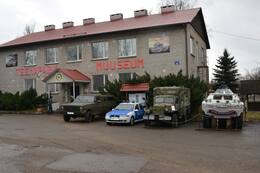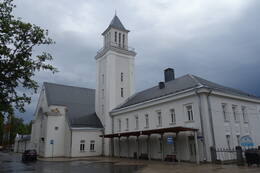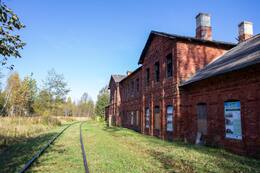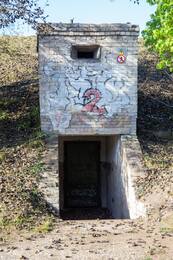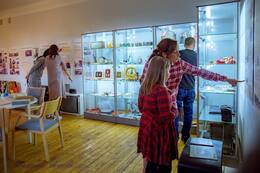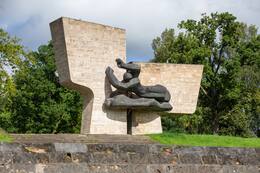The heritage of Soviet Occupation in North Vidzeme and South Estonia
Day 4.
255 km
Tartu–Valga–Seda–Valmiera–Rīga
Practical info
- Driving distance: 255 km
- Due to distances and time, 4 of the listed sights can be visited on this day.
- Opening hours and ticket information for Valga Military Theme Park www.isamaalinemuuseum.ee. Guided group visits should be booked in advance. For the most exciting experience, using the guide services is highly recommended.
- The Defence line “Walk” near Valga is only possible for groups and with advance reservation combined with the visit of Valga military theme park.
- Those interested in experiencing a military atmosphere, can book accommodation in Valga military theme park.
- Underground Military bunkers in Valka are viewable from outside only.
- The visit to Seda House of Culture by prior booking +371 29436275.
- Valmiera audio guide and tourist information visit.valmiera.lv. Audio guide is available in Latvian, English, Russian, German, Estonian languages.
Sights
Valga Military Museum-Theme Park
This museum and theme park showcases the internal security and military history of Valga and Estonia. The place is perfect for organising summer camps with field activities and a field trip to a World War II battle site near the Väike-Emajõgi River. The programme includes learning to cook pea soup (a popular dish in the military), using camouflage face paints and orienteering in the woods.
The exhibition at the theme park includes military equipment, artillery, an Mi-8 helicopter, a fire engine and various types of machine gun pillbox and naval mine. The tour ends at a Forest...
Valga railway station built by German prisoners of war
The main building of Valga railway station (Leningrad Transport Planning Office, architect: Viktor Tsipulin) was completed in 1949. It is an elongated two-storey structure with an avant-corps and a hipped roof, its architectural showpiece being its seven-storey square tower. It is one of the best and most remarkable examples of Stalinist architecture in Estonia. Its original state having been so well preserved further elevates its significance. The railway station was built shortly after World War II in place of a building from the imperial era that Soviet bombing had razed to the ground. Since German prisoners of war were detained in Valga, it is plausible that they were used to construct it.
...Valka train station
The Valka Railway Station is located at the end of Poruka street, next to a set of train tracks that are out of use. The station building can only be viewed from the outside where information stands of the importance of the railway in Valka and Valga are in place. Near the station building is a memorial stone devoted to the people deported to Siberia on 14 June 1941. The station building was constructed around 1896-1897. Narrow-gauge railway lines in the Valka-Rūjiena-Pärnu section were put in place here initially. During World War I, the railway was severely damaged. After establishing the state border, the Valka Railway Station (Valka II) became a border station. In late September 1920, the special Railway Board Commission arrived in Valka. The...
Underground Military Bunkers in Valka
The Valka bunkers are located in the centre of the city of Valka, on the left side of Ausekļa street, next to the Ādams Tērauds School. Visitors can only view the bunkers from the outside. The Soviet Army bunkers in Valka were among the most secret places in Soviet Latvia only accessible to people with special permits. From 1953 to 1989, they were home to the Soviet Army’s strategic missile communications reserve. Large 16 wheelers were used to deliver massive reinforced concrete blocks for building the bunkers. Once completed, all three bunkers were covered with gravel for additional reinforcement and insulation. The bunkers housed a strategic missile communications reserve subordinated to the Leningrad Communications Centre. Silos with army...
Seda cultural heritage (1953-1990) exposition and Stalinist architecture
The town of Seda was originally built as a workers’ village, together with the construction of a peat factory in 1953. The peat factory was declared part of the All-Union Komsomol Shock Construction Project, with young people from all over the Soviet Union coming here. This defined the character and face of the village. In 1954, Seda was granted workers’ village rights. In 1961, the workers’ village was named a township. On 14 November 1991, the township with a rural area acquired the status of the town of Seda with a rural area. An exhibit of cultural and historical heritage is on display at the Seda Culture House. The panels in the exhibition hall showcase the history of development of the Seda area, starting from the historical period when the Salānieši...
Valmiera
For the first time Valmiera is mentioned in the historical sources in 1323. Until the 13th century this place was in the composition of Talava, inhabited by Latgalians. Construction of Valmiera medieval castle began in the beginning of the 13th century, but in 1283, between the Gauja River and Rate River towered church. Location near to the Tartu-Pskov and Novgorod trade routes greatly facilitated the economic development of the populated area. During the 14th-16th century Valmiera was a part of the Hanseatic League. It suffered greatly from wars, epidemics and fires in 16th to 18th century. In the second half of the 19th century the economic boom started again. It was also facilitated by the building of wooden bridge across the Gauja in 1866 and...
Memorial to the soldiers fallen in World War II
The memorial ensemble in Valmiera was unveiled in 1985. World War II Soviet soldiers who fell in the vicinity of Valmiera and victims of Nazi terror have been reburied in the Brothers’ Cemetery. The authors of the memorial ensemble are sculptors Zigrīda Rapa and Juris Rapa, architects Ēvalds Fogelis, Jānis Lejnieks, Jānis Rutkis and Andris Vītols, and Design Engineer Ivars Veldrums. Limestone from the village of Allaži was used to decorate the memorial ensemble. Its main image is the split linden tree of the Coat of Arms of Valmiera city. Two sculptures on each side of the ensemble symbolise the rhythm of life and death. The figures facing the Gauja river form a semi-circular space, marking the boundary between the past and the present. The main...
Places to eat
Cafe “Sinel” in Valga Military Theme Park
Bistro Sinel is located in the yard of Valga Military Theme Park, offers a delicious lunch at an affordable price. Enjoy a refreshing steak with fresh salad, a lovely bowl of soup, or a nice smoothie in the summer – there is a different menu every day!
You can also ask us to set the table for you.
In Valka / Valga visit.valka.lv/en/taste/catering–in–valka; visit.valka.lv/en/taste/catering–in–valga
In Strenči strencunovads.lv/turisms
In Valmiera visit.valmiera.lv/lv/kur_paest




